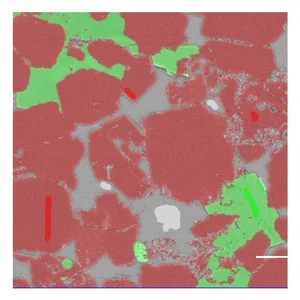Artificial Intelligence and Image Processing in GeoDict 2023
Please note that after activating the video, data will be transmitted to YouTube.
More Information
Abstract
3D imaging techniques, such as µCT and FIB-SEM, are essential tools for material scientists to analyze and design materials at the micro-scale. These techniques enable the acquisition of high-resolution images that can be used in various microscale simulations, including flow and mechanics simulations. Using GeoDict to analyze the geometry of scanned materials, material scientists and engineers can gain valuable insights into a material's microstructural morphology and its impact on its properties. This information can be used to optimize the design of materials for specific applications.

In GeoDict 2023, improvements in AI-based image processing have made 3D imaging techniques more accurate and reliable. For instance, improved AI segmentation algorithms can automatically extract complex structures from 3D images, reducing the time and effort required for manual analysis. Additionally, GeoDict-AI can now enhance the quality of µCT and FIB-SEM images, making it easier to visualize fine details and identify important features. Furthermore, a more accurate alignment algorithm for FIB-SEM in ImportGeo-VOL image slices can improve the accuracy of 3D reconstructions and enable more precise simulations.
Overall, 3D imaging techniques are valuable tools for gaining insights into microstructural morphology and its impact on material properties. With the help of AI-based image processing and analysis in GeoDict, these techniques are becoming more effective and user-friendly, making them accessible to a broader range of researchers and engineers.